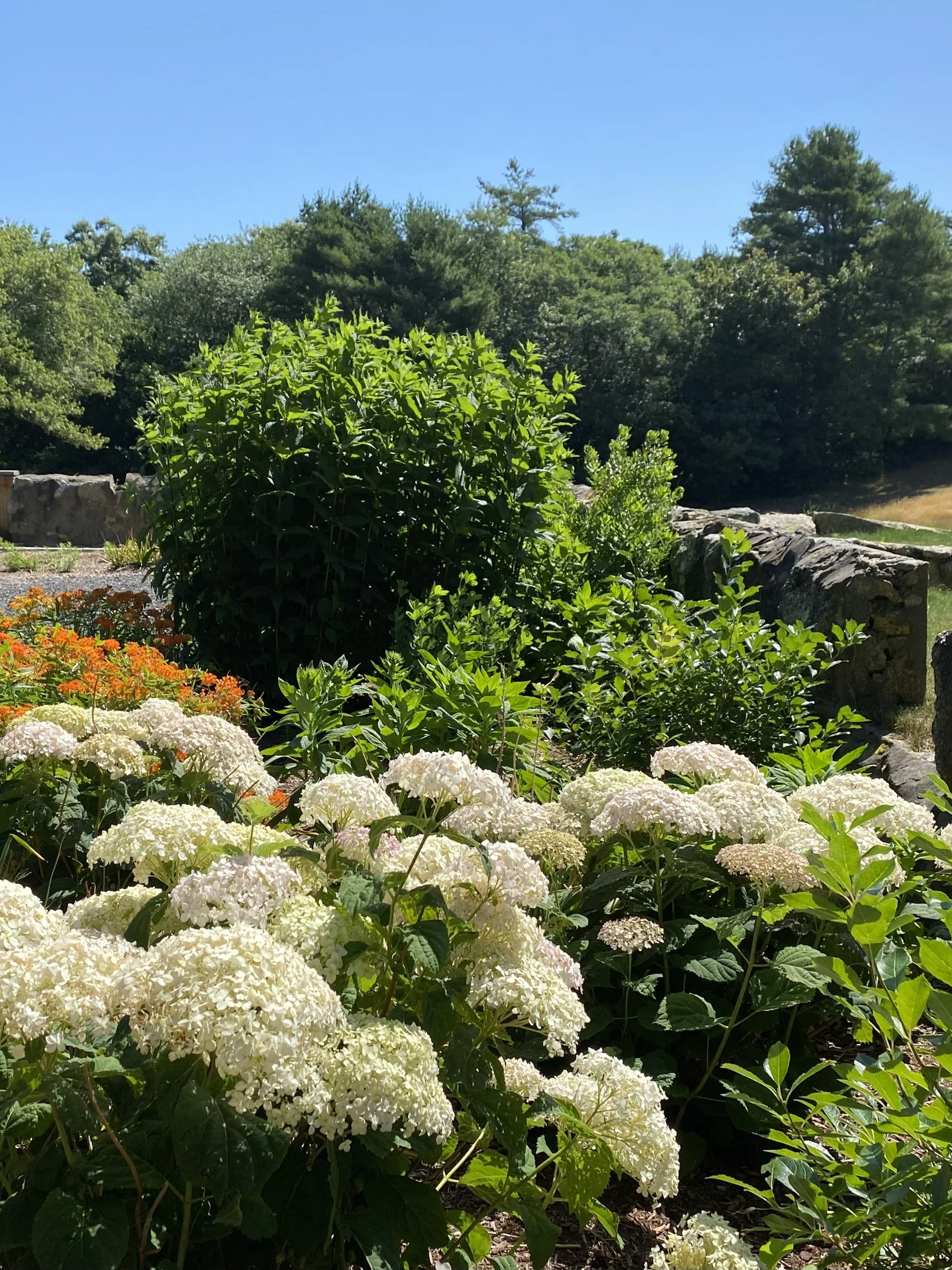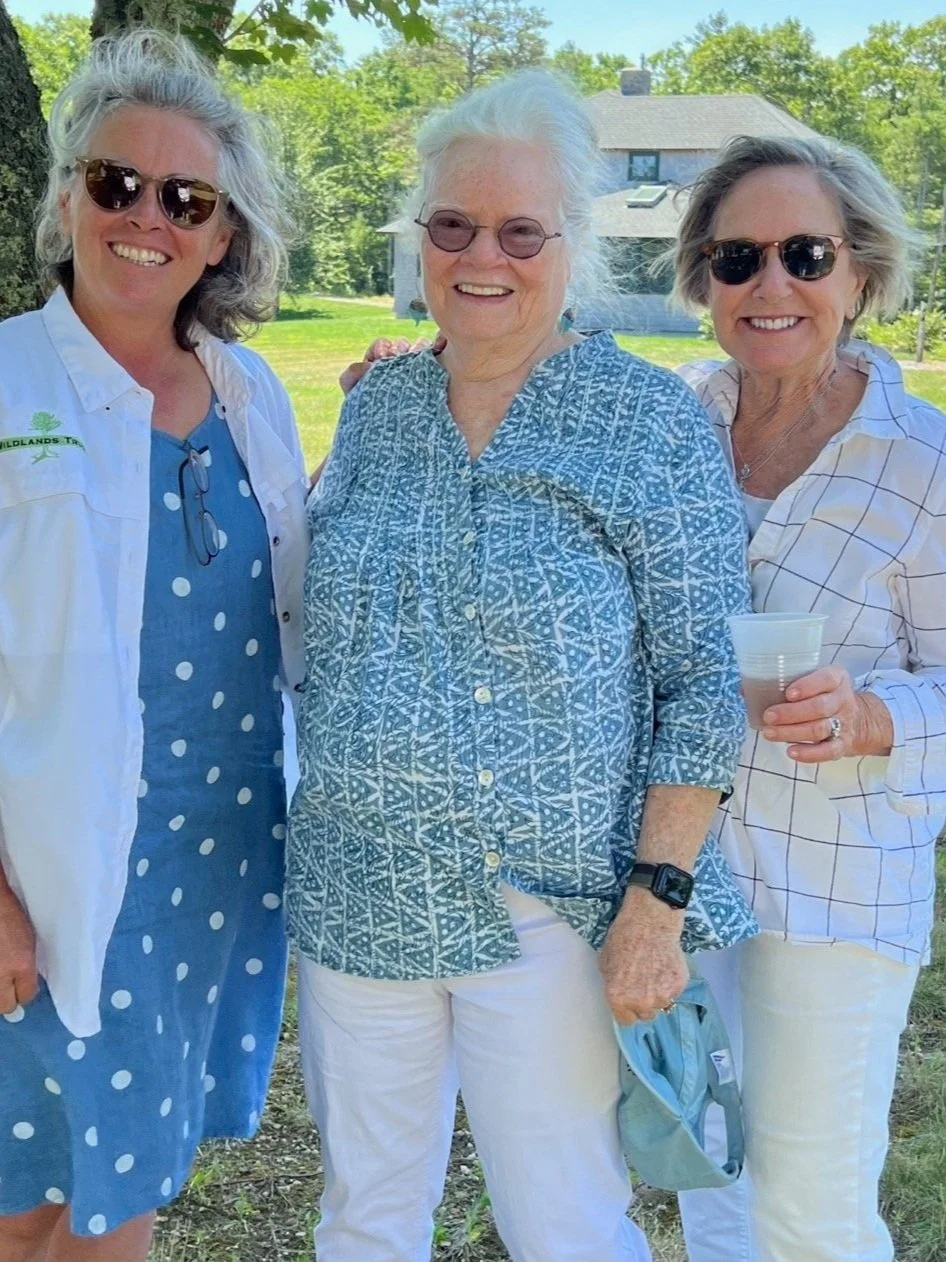What’s New at Wildlands
Welcome Pollinators to Your Garden This Spring
A bee rests on a dahlia in the Community Garden at Davis-Douglas Farm.
By Marilynn Atterbury, Key Volunteer
With the first day of spring right around the corner, green thumbs across Southeastern Massachusetts are twiddling with excitement. Gardeners are already dreaming of the flowers and produce that will revitalize their eyes, noses, and tongues after a long, dark winter.
But in early spring, protect the pollinators that sustain your garden and local ecosystem by leaving busyness to the bees. Believe it or not, the best thing you can do for your pollinator garden right now is nothing at all!
Many pollinators, especially bees and butterflies, spend the winter nestled in garden debris. If you rake up those pesky leaves too soon, you will literally be throwing away this year’s pollinators. Wait until the weather warms to a consistent 50 degrees—usually in late March or early April—for your garden clean-up.
Another early-spring tip: bees wake up hungry! So, make sure to plant early-blooming flowers, such as bleeding heart, lungwort, or ajuga. Even a little sugar water will help.
And don’t forget a water source: a shallow dish with flat rocks (for butterfly perching habitat) will do nicely.
Follow these simple tips this spring, and soon your gardens will be alive with pollinators!
Marilynn (center) helps two high school students restore the Community Garden during Summer of Service.
Marilynn is a primary gardener at Davis-Douglas Farm, and the founder of our pollinator garden. She is also a Wildlands board member, Adopt-a-Preserve lead volunteer, event decorator, and more! Say hello the next time you visit our Plymouth headquarters.
Local College Student Conducts Natural Resource Inventory in Marshfield
By Tess Goldmann, Conservation Restriction Coordinator
Hoyt-Hall Preserve in Marshfield
Last fall, Wildlands Trust had the pleasure of partnering with Unity College student and Carver resident Nicole Huff. As part of her coursework, she completed a natural resource inventory of our Hoyt-Hall Preserve in Marshfield. A natural resource inventory (NRI) is a multifaceted survey of all the animals, plants, soils, waters, and geological features in an area. Hoyt-Hall, one of our showcase preserves, has a wide variety of environments, including pine forest, red maple swamp, and Long Tom Pond. We were excited for Nicole to conduct an NRI of Hoyt-Hall, as her findings would help us identify specific property conservation needs and future projects to address them.
Nicole used multiple methods to survey the property. When I met with Nicole at Hoyt-Hall in September, we walked the property and completed three quadrat sampling sessions. Nicole made five bird observation trips and hung two trail cameras to catch mammal activity. Finally, Nicole collected and analyzed 20 soil samples from around the preserve.
Nicole made several interesting discoveries about the preserve. She found that the upland soil is very acidic, with a pH of 3.62. This soil acidification could be responsible for the deaths of several Eastern red cedar trees around the preserve. In addition, Nicole identified two invasive plants—Oriental bittersweet and European buckthorn, both common in Southeastern Massachusetts—and recommended removal strategies for both.
Nicole also identified 31 birds, which is remarkable, especially during the late end of fall migration. In spring and summer, this number is sure to be higher, making Hoyt-Hall a premier birding location! (See eBird Hotspot data for the preserve here.) Be on the lookout for Downy Woodpeckers, Red-breasted Nuthatches, and many more!
Thank you, Nicole, for all of your hard work! Your project will be an invaluable resource as we continue to advance positive conservation outcomes at Hoyt-Hall Preserve and beyond.
Native Plant Garden in Plymouth Dedicated to Deborah Wood Davis
Read Time: 3 min
By Amy Markarian, Senior Copywriter
On Saturday, July 9, at 10:30am, before the morning sun invited summer’s characteristic heat and humidity, approximately 70 community members gathered at Wildlands Trust’s headquarters on Long Pond Road to dedicate the property’s native plant garden to a longtime supporter of the Trust’s mission, Deborah Wood Davis.
Deborah Wood Davis married into the family of Howland Davis, the previous owner of the land that is now Wildlands’ Davis-Douglas Conservation Area. Her family recalls Deborah’s great affection for the area and, according to her daughter Caroline Chapin, she was excited by Wildlands’ mission and the way it drew the community together. So, when Deborah’s five daughters were looking for a way to honor their mother and the strong roots and connections she had established here, they came to Wildlands Trust.
Sarah Geer, one of those daughters, approached Wildlands’ President and Executive Director Karen Grey to discuss the idea at just the right time. Wildlands had been struggling with the desire to maintain some component of the property’s historic barn, but its crumbling foundation walls and the steep drop from ground level to its interior depth posed hazards that had to be addressed. Simultaneously, local landscape architect Love Howard had also reached out to Karen with the idea of designing a pollinator-friendly garden using native plant species that would support the local ecosystem, and she was looking for a location where she could bring the idea to life. The Davis family’s gift to honor their mother provided the needed support to begin the process of converting the unsafe barn foundation into a showcase garden and educational tool at Wildlands’ headquarters.
The project, according to Karen, “brought together need with opportunity and allowed us to make meaningful connections for people, which are always the best type of projects.” In the fall of 2020, after structural work was completed, the first plants were added by a group of volunteers—including some of Deborah’s daughters, Wildlands volunteer and Board Member Marilynn Atterbury, and others—under Love’s guidance. Today, Marilynn continues the work, along with Wildlands’ gardener Kim Goggin, carefully maintaining and enhancing what is often called “the foundation garden.”
On the morning of the dedication ceremony, the gardening team’s hard work and meticulous care were on full display for the large crowd that had assembled for the occasion. In what would have been Deborah Davis’ 100th year, according to Caroline, the family organized a mini reunion around the dedication ceremony, bringing all five daughters, spouses, children, and almost all of the grandchildren and great-grandchildren together in Plymouth—a gathering of community that would likely have brought the family’s matriarch great pleasure. Also in attendance were several of Wildlands’ staff members, Board members, and supporters. Karen Grey addressed the group with gratitude for all who contributed to the project, Sarah Geer shared reflections of her mother, and Love Howard described her inspiration and plan for the garden’s creation. As the ceremony concluded, with a comfortable breeze under bright blue sky, the flitting of bees and butterflies entertained visitors as they reminisced and explored the newly dedicated Deborah Wood Davis Native Plant Garden.
Spring Has Sprung...Earlier Than Usual?
Read Time: 3 min
By Mitchell Hennings, Land Steward for Wildlife & Habitat
You may have noticed on your outdoor walks and adventures that this year’s trees, shrubs, and flowers began to greet you much earlier in the season, blooming and filling in the gray and brown spaces of the woods with their intricate flowers and leafing patterns. If you noticed this, you might have also wondered why this occurs. Are the plants confused? Are their calendars mixed up? Or is something much larger at play that is influencing plant behavior across the country?
Plants can sense subtle changes within their environment, whether it be early rain or lack thereof, increased photoperiods (longer exposure to the sun), frequent disturbances, or intense weather events. These variables impact how plants progress through their stages of growth to sprouting leaves, fruiting, or developing flowers. Yet, if the timing involved in these processes is off by days or even weeks, like we are now experiencing, there can be untold impacts on the plants whose growth is regulated by it.
This year, plants began to leaf out and fill our forests and roadsides with green earlier than usual, but these growing plants are not naturally occurring in our environment. Plants like Honeysuckle, Bittersweet, Autumn Olive, Multi-Flora Rose, Barberry, and Norway Maple all leaf out much faster than our native plants. These invasive plants had either full leaves or were beginning to bloom before native plants and trees had even begun to produce leaves. The faster phenology of the invasive plants is a clear competitive advantage over the native plants, as they have longer flowering periods and a higher chance of attracting pollinators and going to seed sooner (Kherberger & Holzschuh 2019). This behavior puts increased pressure on native plants to adjust their flowering period earlier in the season, but this may prove to be even more of an issue. If these native plants adjust their flowering period, they could then be impacted by sub-optimal temperatures, low pollinator activity, and a higher chance of dying off (Kherberger & Holzschuh 2019).
Another well measured variable that has been found to contribute to the forward progression of early leaf onset is the decrease in precipitation events. An article published in the journal Nature details a study conducted to understand the impacts of precipitation on native and nonnative plants and how those complex interactions impact leaf onset date, which is when plants produce leaves (Wang et al. 2022). When there are decreased precipitation days, there are also decreased cloudy days to allow for radiation absorption by the plants, which is what signals plants to begin producing leaves (Wang et al. 2022). You don’t need to be a scientist to notice the decrease in rain over the years during the spring season. The adage “April showers bring May flowers” used to ring true ten or twenty years ago, but in today's climate, it looks like flowers bloom in early April, leaving May irrelevant.
Sources:
https://www.nature.com/articles/s41598-019-51916-0
https://www.sciencedaily.com/releases/2022/02/220217155232.htm
Vandalism Threatens Shorebirds at Shifting Lots Preserve
Read Time: 2 min
By Amy Markarian, Senior Copywriter
We are disappointed to report that, for the second year in a row, we are experiencing significant vandalism at Shifting Lots Preserve, in Plymouth. Wildlands' protective fencing that surrounds the shorebird nesting areas, as well as signage informing visitors that dogs are not allowed on the beach, has been damaged and/or removed by visitors on several occasions this spring. The fencing and signs are both critical tools we use to ensure the safety of protected birds on our preserve.
As many of you know, Shifting Lots provides important habitat for Piping Plovers, which are listed as Threatened on both the Massachusetts and Federal Endangered Species Lists, and Least Terns, which are listed as a Species of Special Concern in Massachusetts and are protected under the state Endangered Species Act (MESA).
We know that the Wildlands community cares about local wildlife as much as we do. So, we are asking you to join us in making sure that such acts of vandalism do not continue. If you observe anything unusual and/or see vandalism to our fencing or signage at Shifting Lots Preserve, please take photos and/or videos and reach out to the Plymouth Police Department with the information as soon as possible. We appreciate your support in the protection of these vulnerable species!
(Read Executive Director Karen Grey’s letter to Shifting Lots’ neighbors here.)






























